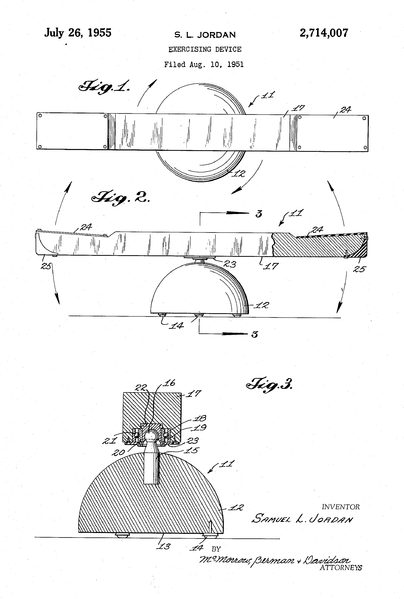File:1951 wobble board precursor by Samuel L. Jordan.png

Original file (1,955 × 2,897 pixels, file size: 111 KB, MIME type: image/png)
Captions
Captions
| Description1951 wobble board precursor by Samuel L. Jordan.png |
These are the three patent drawings for a physical-fitness exercise device. The inventor was Samuel Lightfoot Jordan of Montgomery, Alabama. The 1955 U.S. patent for this device was applied for in 1951. Its patent number is 2,714,007. A case could be made for calling this device (rather than the one invented by Bernard L. Coplin, whose 1957 U.S patent was applied for in 1954) the first patented wobble board, but that claim depends on a too-loose definition of what a wobble board is (a definition that doesn't require a wobble board to be a balance board) because Jordan's patent says that the user "may place his feet on the respective pad elements while supporting his body with his hands in any suitable manner and treads alternately with his feet, whereby his foot and leg muscles are alternately flexed, providing an action similar to swimming or running." (Emphasis added.) Calling this device a wobble board is calling a tricycle a bicycle. Mechanisms by which the body senses and computes its imbalance and mechanisms by which the body maintains its balance when all of its weight is on its feet on a surface as unstable as a wobble board aren't activated when the hands are holding on to a stable support. The balance training given by a wobble board is much more rigorous than the balance training given by the device that is shown in these three patent drawings. (This device gives more rigorous aerobic and muscle-building exercise than a wobble board does because a user can move faster and keep from landing longer than a wobble board's user can.) It might be supposed that the word "may" in the abovequoted sentence from the patent indicates or suggests that the standing user's hands weren't meant to always need to hold onto some external stationary support (i.e., that this device is a wobble board), but there are five reasons to believe that the word "may" there doesn't indicate this: Nowhere does the patent say that an alternative posture is standing on the board without holding on to something else. The only alternative posture specified is that "the user may recline on the ground and grasp the ends of the bar...." The patent's mention of alternating the use of the left and right leg as in swimming and running assumes a degree of control that is beyond the ability of someone on a wobble board whose feet are supporting all of his or her weight. If the device had been intended to withstand the wobbling of a person's entire weight, the fulcrum's post, ball and socket would probably have been thicker than they are in the patent's drawing. The unlikely "s" in the word "treads" in the above quote from the patent ("may place his feet...and treads") suggests that the writer's original sentence didn't include "may." Nowhere does the patent say that balancing is one of the user's activities. (Of course, the user does need to balance while standing on this device, as a person also does while walking or sitting, but the patent's omission of this detail seems to indicate that this task is not challenging enough to be notable, which it would be if the user weren't holding onto an external support.) |
|||
| Date | ||||
| Source |
Patent 2,714,007 of the U.S. Patent and Trademark Office |
|||
| Author | Samuel Lightfoot Jordan | |||
| Permission (Reusing this file) |
|
File history
Click on a date/time to view the file as it appeared at that time.
| Date/Time | Thumbnail | Dimensions | User | Comment | |
|---|---|---|---|---|---|
| current | 16:38, 9 September 2011 |  | 1,955 × 2,897 (111 KB) | DavidMaisel (talk | contribs) | {{Information |Description= These are the three patent drawings for a physical-fitness exercise device. The inventor was Samuel Lightfoot Jordan of Montgomery, Alabama. The 1955 U.S. patent for this device was applied for in 1951. Its patent number is |
You cannot overwrite this file.
File usage on Commons
There are no pages that use this file.
Metadata
This file contains additional information such as Exif metadata which may have been added by the digital camera, scanner, or software program used to create or digitize it. If the file has been modified from its original state, some details such as the timestamp may not fully reflect those of the original file. The timestamp is only as accurate as the clock in the camera, and it may be completely wrong.
| Horizontal resolution | 28.35 dpc |
|---|---|
| Vertical resolution | 28.35 dpc |
| Software used | |
| File change date and time | 22:08, 12 August 2011 |